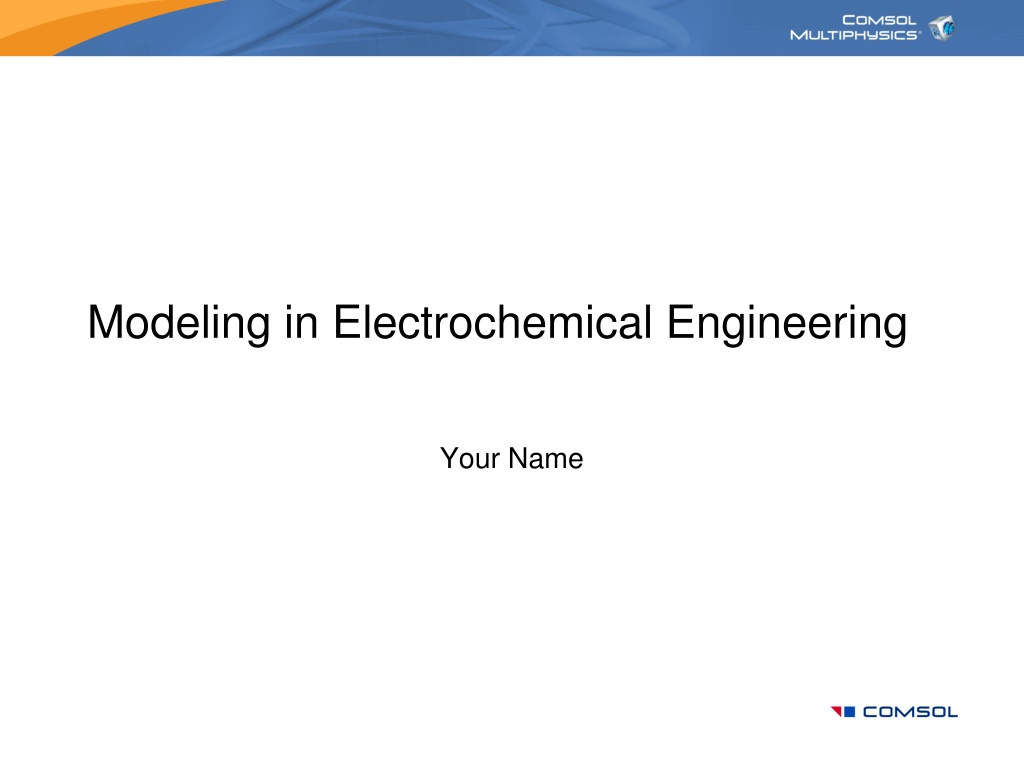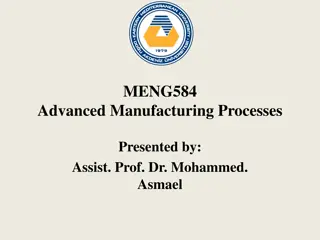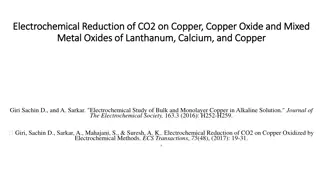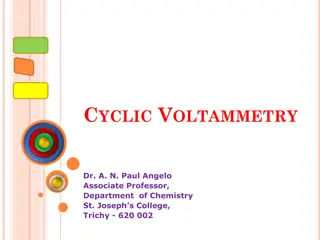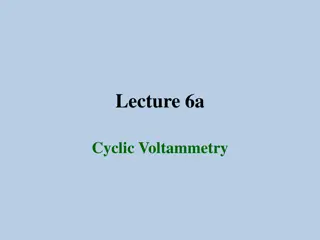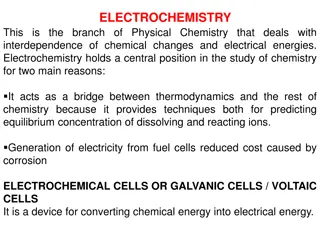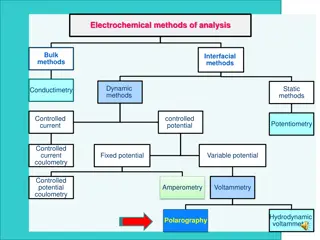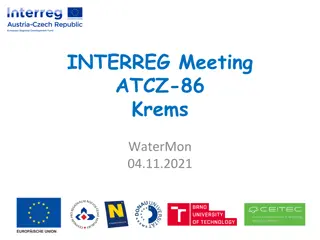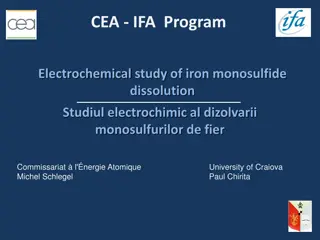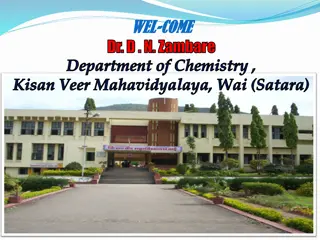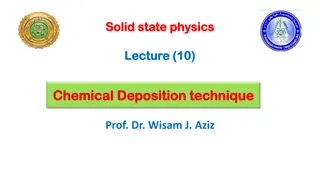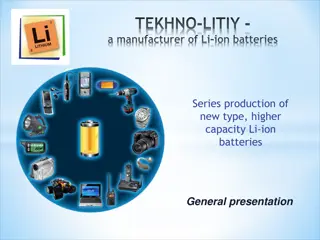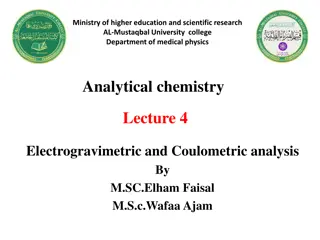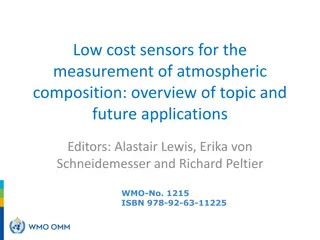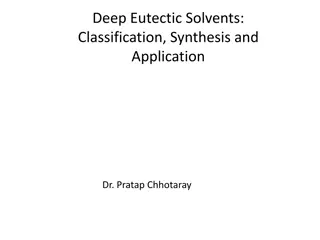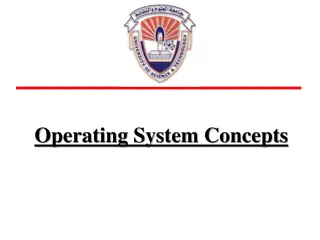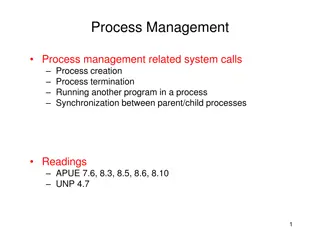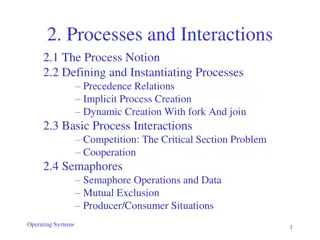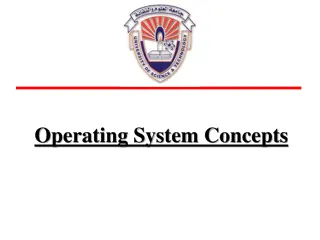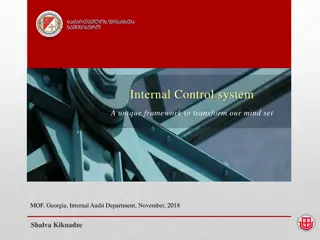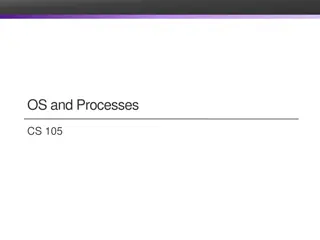Understanding Electrochemical Systems and Processes
Electrochemical engineering involves the study of devices and processes that convert chemical energy to electrical energy through ionic conductors. This field explores redox reactions, energy-producing processes, electrocatalysis, anodic and cathodic reactions, and the interplay between thermochemical and electrochemical processes. Understanding transport phenomena and electrode kinetics is crucial for optimizing electrochemical reactions and overall system performance.
- Electrochemical engineering
- Redox reactions
- Energy conversion
- Electrode kinetics
- Transport phenomena
Download Presentation

Please find below an Image/Link to download the presentation.
The content on the website is provided AS IS for your information and personal use only. It may not be sold, licensed, or shared on other websites without obtaining consent from the author. Download presentation by click this link. If you encounter any issues during the download, it is possible that the publisher has removed the file from their server.
E N D
Presentation Transcript
Modeling in Electrochemical Engineering Your Name
Introduction: Electrochemical Systems Electrochemical systems are devices or processes in which an ionic conductor mediates the inter-conversion of chemical and electrical energy The reactions by which this inter- conversion of energy occurs involve the transfer of charge (electrons) at the interface between an electronic conductor (the electrode) and an ionic conductor (the electrolyte)
Introduction: Redox Reactions Individual electrode reactions are symbolized as reduction- oxidation (redox) processes with electrons as one of the reactants: + Ox ne Red Ox = oxidized species Red = reduced species e-= electron n = electron stoichiometry coefficient.
Introduction: Thermochemical and Electrochemical Processes
Introduction: Energy Producing and Energy Consuming Electrochemical Processes
Introduction: Spontaneous Processes and Processes that Require Energy Input
Introduction: Transport and Electrochemical Reactions Transport Diffusion, convection, migration, which is an electrophoretic effect on ions. The mobility and concentration of ions yields the mass transfer and Ohmic resistances in the electrolyte Electrochemical reaction Electrode kinetics for an electron charge transfer step as rate determining step (RDS) yields potential-dependent reaction rate. The overpotential is a measure of the activation energy (Arrhenius equation -> Butler- Volmer equation)
Introduction: Transport Concentration Diffusivity Flow velocity Charge Mobility Transport Flux = diff. + conv. + migration = D c + z m Fc N u c i i i i i i i l Ionic potential Faraday s constant sumof charges Current density F = ( ) z 2 = + j u F z D c i i z c m Fc j N z i i i l i i i i i i i i i ( ) z 2 Electroneutrality sum of charges = 0 = j F z D c m Fc i i i l i i i i i ( ) z 2 Perfectly mixed primary and secondary = j F m Fc i i i l i = conductivity
Introduction: Conservation of Species and Charge c t Conservation of species n-1 species, n:th through charge conservation ( ) = D c + + u i c z m Fc R i i i i i i l i Reaction rate ( ) z 2 = j F z D c m Fc Conservation of charge i i i l i i i i i Net charge is not accumulated, produced or consumed in the bulk electrolyte ( ) z 2 = 0 F z D c m Fc i i i l i i i i i ( ) = 0 For primary and secondary cases l
Modeling of Electrochemical Cells Primary current distribution Accounts only for Ohmic effects in the simulation of current density distribution and performance of the cell: Neglects the influence of concentration variations in the electrolyte Neglects the influence of electrode kinetics on the performance of the cell, i.e. activation overpotential is neglected (losses due to activation energy) Secondary current distribution Accounts only for Ohmic effects and the effect of electrode kinetics in the simulation of current density distribution and performance of the cell: Neglects the influence of concentration variations in the electrolyte Tertiary current distribution Accounts for Ohmic effects, effects of electrode kinetics, and the effects of concentration variations on the performance of a cell
Modeling of Electrochemical Cells Non-porous electrodes Heterogeneous reactions Typically used for electrolysis, metal winning, and electrodeposition Porous electrodes Reactions treated as homogeneous reaction in models although they are heterogeneous in reality Typically used for batteries, fuel cells, and in some cases also for electrolysis Electrolytes Diluted and supporting electrolytes Concentrated electrolytes Free electrolytes with forced and free convection Immobilized electrolytes through the use of porous matrixes, negligible free convection, rarely forced convection Solid electrolytes, no convection
A First Example: Primary Current Distribution Assumptions: Perfectly mixed electrolyte Negligible activation overpotential Negligible ohmic losses in the anode structure Anode: Wire electrode Cathodes: Flat-plate electrodes Electrolyte Cathodes: Flat-plate electrodes
A First Example: Subdomain and Boundary Settings Subdomain: Charge continuity Anode: Cell voltage = 1.3 V E0= 1.2 V Total cell (in this case ohmic) polarization = 100 mV Boundary Electrode potentials at electrode surfaces Insulation elsewhere Cathodes: 0 V Electrolyte: ( ) Cathodes: Electrode potential = 0 V E0= 0 V (negligible overpotential) = 0 l l = Ionic potential
A First Example: Some Definitions Activation and concentration overpotential = 0 0 = = = 0 E E , 0, l c c E , 0, l a cell a = E 0 s l l = Ionic potential = E 0 l s s = Electronic potential E = Cell voltage Select the cathode as reference point 0 s c = E = cell a = , At anode, index c = At cathode, index , , cell s a s c
A First Example: Some Results Potential distribution in the electrolyte Current density distribution at tha anode surface Highly active catalyst Inactive catalyst
A Second Example: Secondary Current Distribution Activation overpotential taken into account New boundary conditions ( ) = n cti = E 0 s l l Charge transfer current at the electrode surfaces ( ) 1 F F = i i exp exp 0 ct R T R T g g Exchange current density Faraday s constant Gas constant Charge transfer coefficient
Comparison: Primary and Secondary Current Distributions Polarization curves Current density distribution at the anode surface Solid line = Primary Dashed line = Secondary Effect of Activation overpotential Lower current density with equal cell voltage (1.3V) compared to primary case
Comparison: Primary and Secondary Current Density Distribution, 0.1 A Total Current Dimensionless current density disribution, primary case Dimensionless current density disribution, secondary case Independent of total current Dependent of total current i = ct cdd ct average i ,
Some Results: Mesh Convergence Polarization curves for three mesh refinements (four mesh cases) Total current, seven mesh cases (up to 799186 elements)
Primary and Secondary Current Distributions: Summary and Remarks Primary case gives less uniform current distribution than the secondary case: The addition of charge transfer resistance through the activation overpotential forces the current to become more uniform Secondary current density distribution is not independent of total current: The charge transfer resistance decreases with increasing current density (overpotential increases proportional to the logarithm of current density for high current density) Home work: The geometry is symmetric in this example. Use this geometry and treat the wire electrode as a bipolar electrode placed in between an anode and a cathode
Tertiary Current Density Distribution Use the secondary current distribution case as starting point Add the flow equations, in this case from single phase laminar flow Navier- Stokes Solve only for the flow Add equations for mass transport, in this chase the Nernst-Planck equations Introduce the concentration dependence on the reaction kinetics Solve the fully coupled material and charge balances using the already solved flow field
Results: Concentration and Current Density Distribution Stagnation in the flow results in lower concentration Main direction of the flow
Concluding Remarks Use a primary current distribution as the starting point Introduce reaction kinetics to obtain secondary current distribution Introduce a decoupled flow field Introduce material balances and concentration dependency in the reaction kinetics to obtain a tertiary current distribution Several options: Supporting electrolyte where the conductivity is independent of concentration All charged species are balanced and are combined in the electroneutrality condition All charged species are balanced but they are combined using Poisson s equation
